Spanish cuisine, known globally for its vibrant flavors and Mediterranean heart, is far more than mere sustenance; it is a profound expression of the nation’s complex history, regional diversity, and deep-seated communal values. The peninsula has been a melting pot of culinary traditions, influenced successively by Romans who established olive oil and wine culture, the Moors who introduced rice, saffron, and aromatic spices, and finally, the New World voyages that brought staples like the tomato and potato.
This rich heritage has culminated in a gastronomy that emphasizes fresh, high-quality, seasonal ingredients and, crucially, the social ritual of eating. The shared plate is a sacred space in Spain, turning every meal—from a casual round of tapas to a grand Sunday paella—into an act of communion and connection. The UNESCO recognition of the Mediterranean diet as Intangible Cultural Heritage further validates this way of life, recognizing its positive impact on both physical and social well-being.
At Spiritual Culture, we explore the spiritual resonance of these dishes. Our ranking is not just based on tourist popularity, but on the enduring historical roots, regional identity, and the profound role each food plays in bringing families and communities together. Each dish below represents a chapter in Spain’s story, offering a lesson in patience, gratitude, and the enduring beauty of simplicity.
Table of the Top 10 Most Culturally Significant Spanish Foods
| Rank | Dish Name | Region of Origin/Significance | Core Cultural Value | Spiritual Anchor |
|---|---|---|---|---|
| 1 | Paella Valenciana | Valencia | Communal Feast, Family Unity | Gratitude for the Harvest (Rice/Saffron) |
| 2 | Jamón Ibérico | Iberian Peninsula (Dehesa) | Patience, Quality, National Pride | Reverence for the Land and Time |
| 3 | Tortilla Española | Nationwide Staple (Debated Origin) | Simplicity, Versatility, Everyday Comfort | The Wisdom of Using Simple Means |
| 4 | Tapas (Culture/Concept) | Andalusia/Nationwide | Sociability, Conviviality, Shared Experience | Communion, Breaking Bread Together |
| 5 | Gazpacho / Salmorejo | Andalusia (Moorish Roots) | Adaptability, Seasonal Purity, Refreshment | The Gift of Coolness and Purity |
| 6 | Churros con Chocolate | Nationwide/Madrid | Celebration, Warmth, Morning Ritual | Ritual, The Sweetness of Simple Pleasures |
| 7 | Pulpo a la Gallega | Galicia | Regional Identity, Coastal Heritage | Respect for the Sea and the Fishermen |
| 8 | Croquetas | Nationwide (Legacy of Conservation) | Frugality, Resourcefulness, Home-making | The Value of ‘Waste Not, Want Not’ |
| 9 | Pimientos de Padrón | Galicia (Padrón) | The Surprise Element, Localism | Acceptance of the Unknown (‘Pica ou non pica’) |
| 10 | Fabada Asturiana | Asturias | Heartiness, Regional Comfort, Winter Sustenance | Endurance and Sustenance for the Body and Soul |
Top 10. Fabada Asturiana
Hailing from the cool, rugged northern region of Asturias, Fabada Asturiana is more than a stew; it is a spiritual anchor against the winter chill. Traditionally made with large white beans (faba de la Granja), pork shoulder, black sausage (morcilla), and chorizo, this hearty dish reflects the resilience and agricultural abundance of its mountainous home. As of the Current Time of Writing, it remains a beloved example of regional pride, its richness perfectly suited to Asturias’s climate and deep-rooted rural traditions.
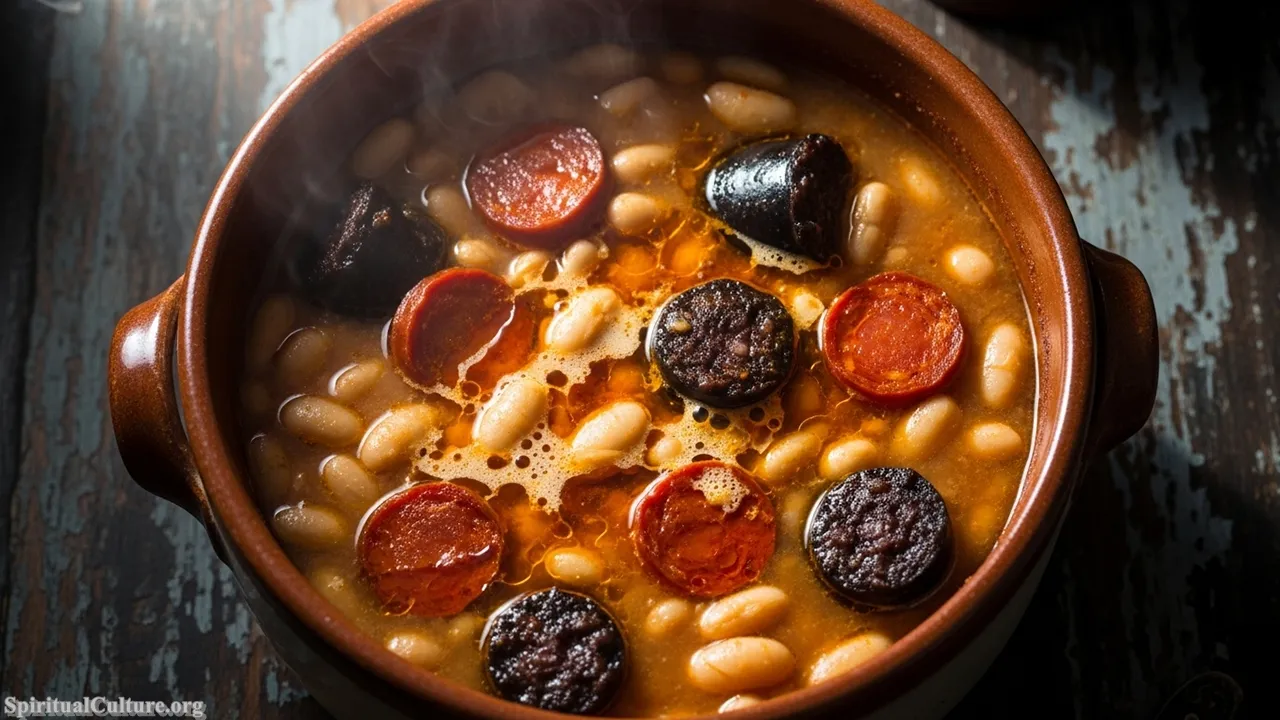
Its spiritual impact lies in its power as a slow-cooked, deeply sustaining meal. The lengthy simmering process—often taking several hours—teaches a lesson in patience, transforming simple ingredients into a complex, nourishing experience. Fabada symbolizes endurance and the strength of community, traditionally consumed in large, shared pots that feed the body and warm the soul during the coldest months. Its preparation is a ritual that honors the sacrifice of the harvest and the livestock.
The moral lesson of Fabada is the wisdom of building something great from simple, honest elements. It reminds us that true sustenance comes not from speed, but from deliberate, unhurried care. Its preservation value rests in its unyielding traditionalism, resisting modern culinary trends to remain a powerful taste of Asturian identity and heartland comfort.
Cultural/Spiritual Highlights
- Faba beans are protected with a geographical indication (I.G.P.) status.
- Symbolizes deep winter comfort and the agrarian heritage of northern Spain.
- Its slow cooking time embodies the spiritual principle of patience.
Top 9. Pimientos de Padrón
These small green peppers, a Galician specialty from Padrón, are a deceptively simple tapa, flash-fried in olive oil and coarse salt. The cultural intrigue surrounding the Pimientos de Padrón stems from a famous Spanish riddle: “Some are hot and some are not” (Os pementos de Padrón, uns pican e outros non). This culinary gamble, a tiny, playful risk with every bite, makes them a highlight of any shared meal, constantly updated in the tapas scene as of the Current Time of Writing.
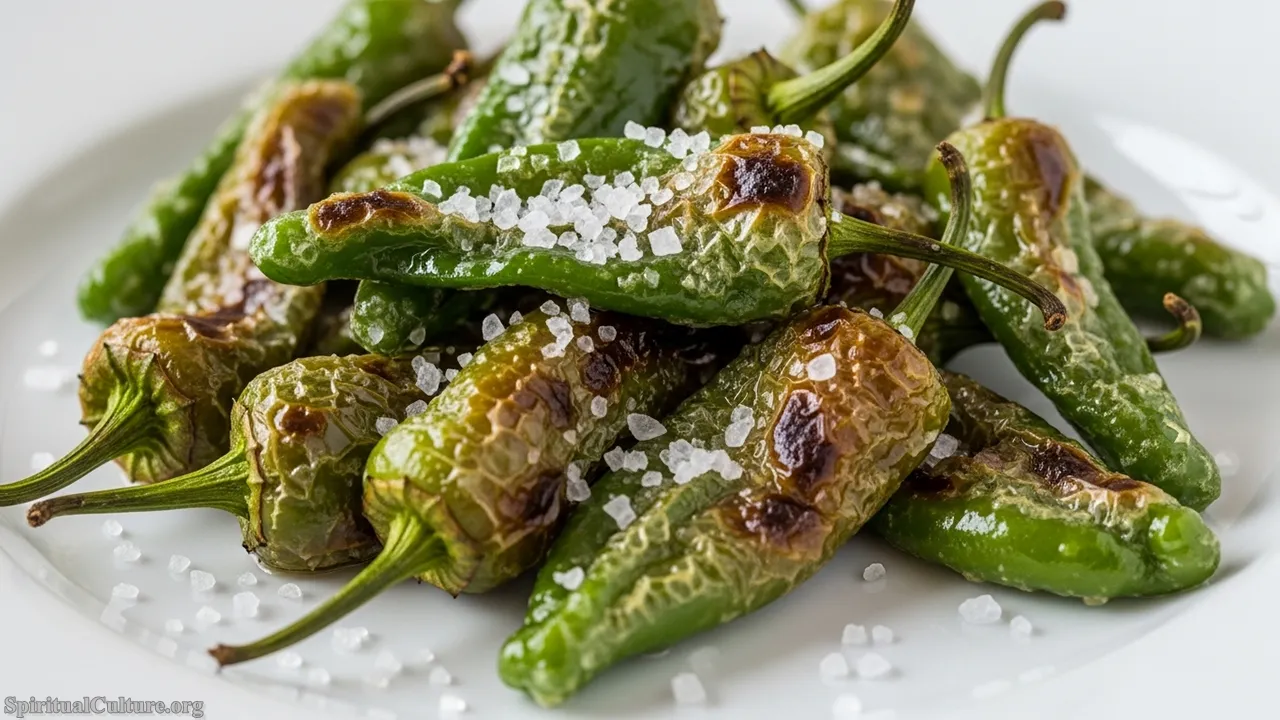
The spiritual value of this dish lies entirely in its unpredictability—it is a lesson in acceptance and living in the moment. When sharing this tapa, the diner practices non-attachment to outcome, accepting that the next pepper might be mild or deliver a startling burst of heat. This mirrors the spiritual journey, where unexpected challenges (the spicy pepper) are inevitable, but are embraced as part of the overall experience of life and communion.
Ultimately, Pimientos de Padrón celebrate the beauty of regional specialties and the human spirit’s capacity for surprise and shared laughter. The dish compels conversation, turning a small plate into a focal point of communal interaction. The act of sharing these peppers is a lighthearted nod to destiny and the shared vulnerability of the dining table.
Cultural/Spiritual Highlights
- The famous phrase “Some are hot, some are not” is a spiritual metaphor for acceptance.
- Celebrates Galician agricultural tradition and local pride.
- An essential element of the communal, conversational tapas experience.
Top 8. Croquetas
Croquettes, or Croquetas, are a staple on almost every Spanish menu, from upscale restaurants to humble tapas bars. Their core identity is rooted in the tradition of culinary frugality and genius—a creamy, savory béchamel interior is often filled with leftovers, such as shredded ham (jamón), chicken, or salt cod (bacalao), then breaded and deep-fried. This practice highlights a historical reverence for resources, a deep-seated cultural value of making a feast out of what’s available, remaining a highly-varied national favorite as of the Current Time of Writing.
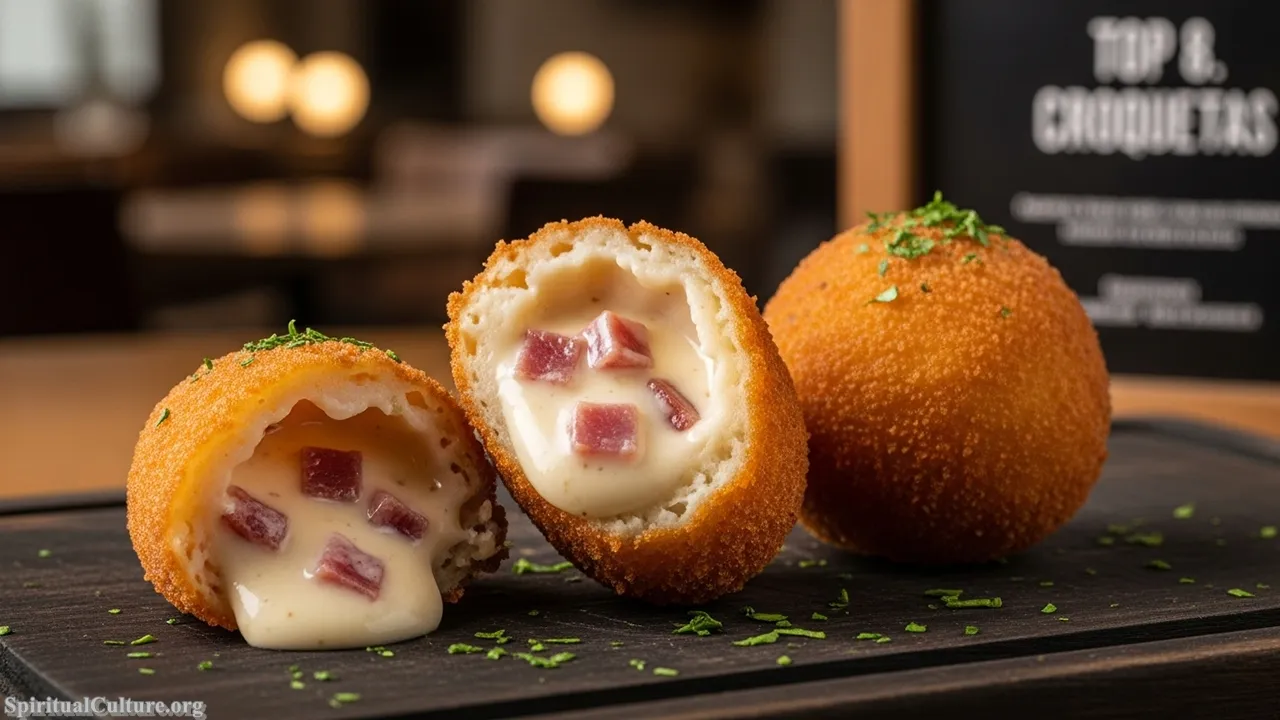
The spiritual impact of the croquette is found in its principle of “waste not, want not.” It is a testament to the resourcefulness that sustained households through harder times, elevating humble remnants into an irresistible delicacy. They transform fragmented ingredients into a whole, cohesive, and perfect bite. This act of transformation serves as a powerful metaphor for renewal and the potential for beauty found in what others might discard.
The reflection offered by the croqueta is on the quiet virtue of practicality and the creativity born from necessity. It is the food of the home, a warm, reassuring presence that grounds the Spanish culinary landscape. Its preservation is ensured by its deeply comforting texture and flavor, symbolizing the universal warmth and care of home-cooked food.
Cultural/Spiritual Highlights
- The ultimate dish of culinary resourcefulness and historical frugality.
- The creamiest variations are a symbol of a mother’s patient cooking.
- A ubiquitous and unifying dish found in every region and social class.
Top 7. Pulpo a la Gallega (Polbo á Feira)
Known in Galician as Polbo á Feira (Fair-style Octopus), this dish features tender boiled octopus, sliced and generously seasoned with paprika (pimentón), coarse salt, and olive oil, traditionally served on wooden plates with boiled potatoes. It is a powerful symbol of Galician coastal identity and tradition, demonstrating a deep cultural pride in local, high-quality seafood. The meticulous preparation of the octopus, requiring a specific boiling technique to achieve perfect tenderness, is a craft passed down through generations of “pulpeiras.”
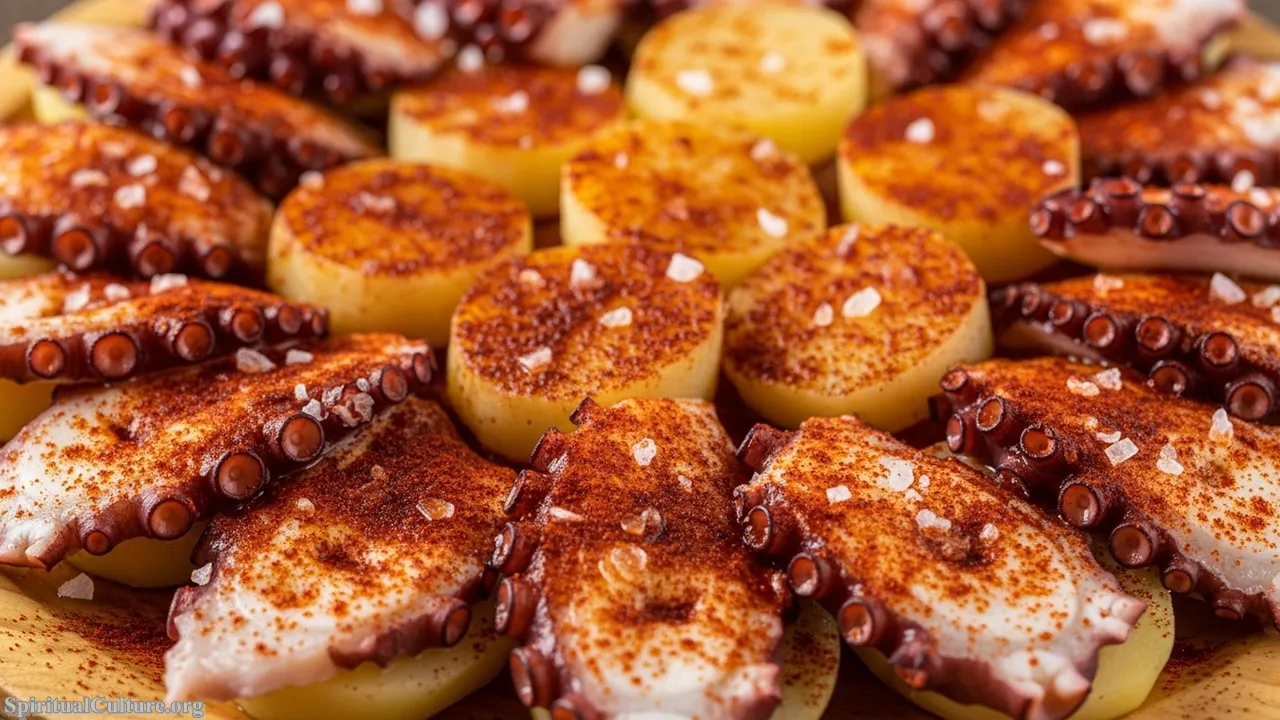
The spiritual relevance of the Pulpo a la Gallega is tied to the maritime spirit and the respect for the sea. The consumption of this dish is a sensory connection to the Atlantic coast, honoring the work of the fishermen and the bounty of the ocean. Its traditional presence at local fairs (feiras) underscores its role as a celebratory meal, marking moments of community gathering and trade, making it a sacred food for regional celebration.
This dish reflects the cultural virtue of respecting regional expertise and honoring the source of one’s food. Its preparation teaches the discipline required to transform a challenging ingredient into an exquisite, simple meal. It is a reminder that the best feasts are those closest to the land—or the sea—that sustains them.
Cultural/Spiritual Highlights
- A potent symbol of Galicia’s maritime heritage and regional pride.
- Preparation is a revered craft, often carried out by generations of ‘pulpeiras’.
- Traditionally eaten at fairs and markets, symbolizing community commerce.
Top 6. Churros con Chocolate
Churros con chocolate is the quintessential Spanish treat, particularly revered as a celebratory breakfast or late-night snack in cities like Madrid. The churro itself is a simple, star-shaped fried dough, but its profound cultural status comes from the ritual of dipping it into a thick, almost pudding-like, rich hot chocolate. This pairing is a warm, enveloping comfort, a simple indulgence that has remained essentially unchanged and culturally significant as of the Current Time of Writing.

The spiritual meaning of this combination lies in its role as a ritualistic and celebratory food. Served traditionally on New Year’s Day and often after a night of festivities, it represents the sweet punctuation of significant moments. The churro’s crisp exterior and soft interior, combined with the luxurious warmth of the chocolate, offer an accessible moment of bliss—a reminder that the sweetness of life is often found in shared ritual and simple, decadent pleasures. It is a moment to pause, gather, and indulge.
This tradition offers a reflection on the importance of ritual in grounding human experience. It encourages us to designate time for shared joy and to embrace the small, warm comforts of life. The preservation of this simple tradition, particularly through dedicated churrerías, safeguards a distinctively Spanish moment of collective happiness.
Cultural/Spiritual Highlights
- The essential treat for New Year’s Day and post-festival rituals.
- The warmth and richness symbolize accessible, shared spiritual comfort.
- Its consumption is tied to dedicated, traditional churrerías, preserving the ritual space.
Top 5. Gazpacho / Salmorejo
The chilled soups of Andalusia, Gazpacho and its thicker, creamier cousin Salmorejo, are culinary masterpieces born of necessity and climate. These liquid salads, typically made from blended raw tomatoes, olive oil, garlic, and sometimes bread, are a cultural testament to the wisdom of the Mediterranean diet. They represent a direct, unadulterated connection to the sun-drenched harvest of southern Spain, evolving from ancient Roman and Moorish influences into the refreshing, staple dishes they are as of the Current Time of Writing.
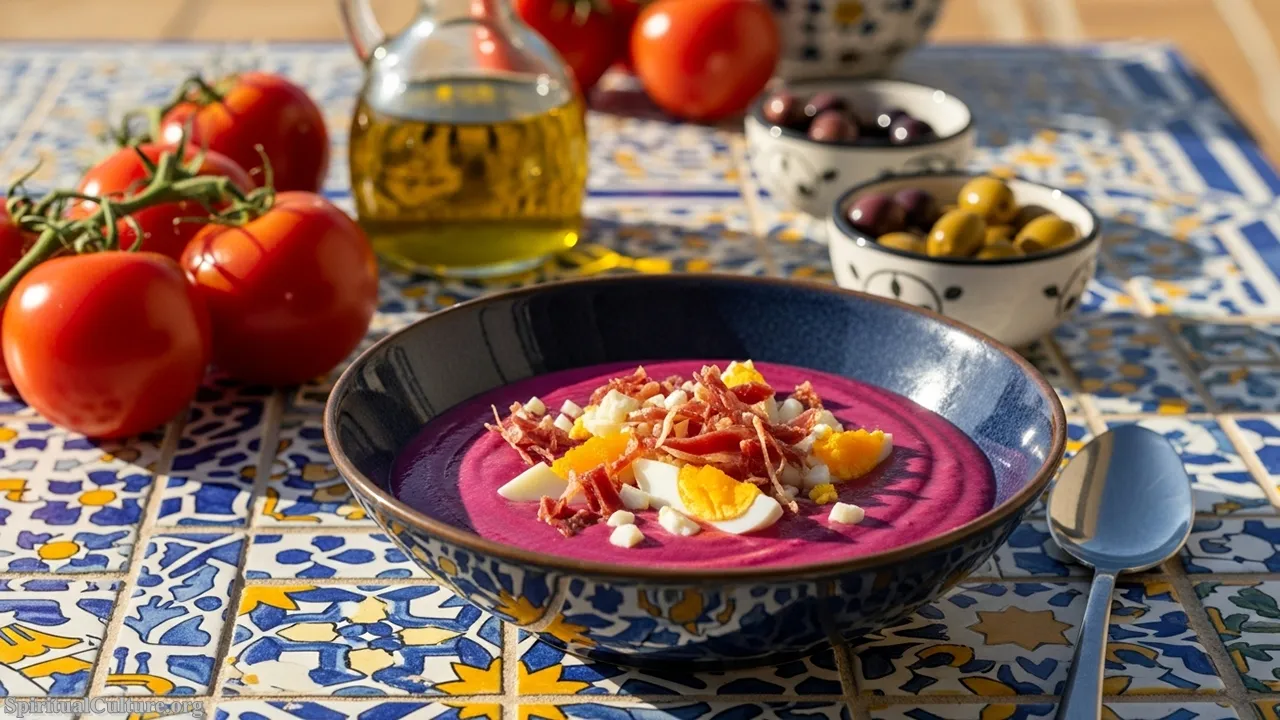
Their spiritual value lies in their purity, their power to refresh, and their connection to the region’s diverse history. The Moorish influence, which introduced essential ingredients and a refined approach to cooking, is a profound historical layer. Gazpacho is the gift of coolness in the face of the oppressive Andalusian summer heat—a metaphor for finding internal peace and purity when the external world is challenging. It embodies the essence of “liquid health,” reflecting a deep respect for seasonal and local produce.
This tradition teaches the moral lesson of adaptability and the perfection of simplicity. By highlighting the peak flavor of just a few ingredients, it reminds us that true quality often resides in the unadorned. Its preservation is a celebration of the Mediterranean diet’s core values: freshness, vitality, and health, all achieved through natural means.
Cultural/Spiritual Highlights
- The ultimate celebration of the Mediterranean diet and raw, seasonal purity.
- The chilling and refreshing effect is a spiritual balm against summer heat.
- Its core ingredients reflect centuries of Moorish and Roman culinary history.
Top 4. Tapas (The Culture and Concept)
Tapas are not a single food but a social and culinary phenomenon—small, savory dishes served with a drink, often taken standing up while moving between different bars (ir de tapas). Originating from the custom of covering (tapar) a glass of sherry with a piece of bread or ham to keep out dust or flies, the concept has evolved into the very heart of Spanish conviviality. The continuous tradition of tapeo, or tapas bar-hopping, remains the nation’s most sacred social ritual as of the Current Time of Writing.

The spiritual impact of the Tapas concept is immense, centering entirely on the ideal of Communion. The shared plate forces interaction, negotiation, and an outward focus, contrasting with the solitary dining often found elsewhere. It is a decentralization of the meal, valuing conversation and shared experience over the single large plate. Tapas embodies the Spanish spirit of generosity, spontaneity, and the profound human need to break bread together outside the formal setting.
Tapas offer a reflection on the virtue of sociability, emphasizing that nourishment for the soul is as important as nourishment for the body. The ritual reminds us that life’s great pleasures are found in motion and connection. Its preservation is vital, as the culture of tapeo ensures that the Spanish street and bar remain a vibrant, living space for community bonding.
Cultural/Spiritual Highlights
- The concept is the ultimate symbol of Spanish conviviality and social gathering.
- Emphasizes ‘communion’ and shared experience over solitary consumption.
- The practice of ‘ir de tapas’ is a sacred, unwritten social ritual.
Top 3. Tortilla Española (Potato Omelette)
The Tortilla Española, or Spanish Omelette, is perhaps the most democratic and ubiquitous dish in all of Spain, served in every café, bar, and home, at any time of day. Made simply from eggs, potato, and olive oil (with the hotly debated addition of onion), its universal presence belies its profound cultural weight. It is a culinary bedrock—simple, substantial, and infinitely versatile, representing the reliable foundation of Spanish home cooking as of the Current Time of Writing.

The spiritual significance of the Tortilla lies in its embrace of simplicity and the universal value of humble ingredients. It is a dish of pure synthesis, transforming the ordinary (potatoes and eggs) into a comforting, cohesive, and deeply satisfying form. The debate over its composition (with or without onion) further elevates it into a cultural icon, proving that even the simplest food can be a passionate expression of regional or personal identity—a vessel for spirited, yet loving, disagreement.
The reflection offered by the tortilla is the wisdom of finding greatness in the everyday. It is a reliable comfort, a dish that never fails to satisfy or remind one of home. Its cultural preservation is guaranteed by its role as the ultimate expression of Spanish ingenuity: a perfect circle of sustenance, born of the New World potato and Old World eggs and oil.
Cultural/Spiritual Highlights
- A culinary canvas symbolizing simplicity, resourcefulness, and reliability.
- The potato (New World) and egg (Old World) fusion reflects Spain’s global history.
- Its universal presence makes it the symbolic food of home and national unity.
Top 2. Jamón Ibérico
Jamón Ibérico, the prized cured ham from the black Iberian pig, is arguably Spain’s greatest culinary treasure. Its production—from the specific breeding of the pigs (often acorn-fed on the dehesa) to the meticulous, years-long curing process—is an art form steeped in patience and tradition. It is a national icon, symbolizing a commitment to quality, slow time, and the unique geography of the Iberian Peninsula, commanding a revered position in gastronomy as of the Current Time of Writing.
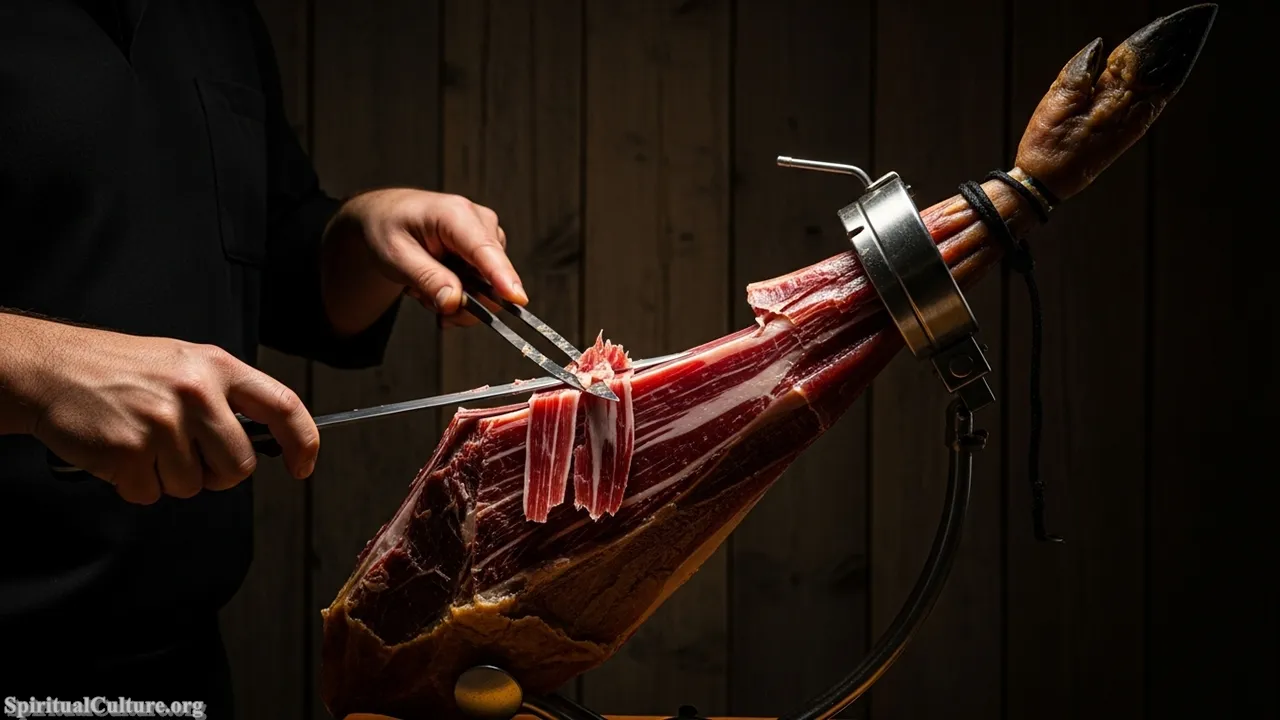
The spiritual significance of Jamón Ibérico is its embodiment of Patience and Reverence for Time. The final product is a result of years of dedicated work and waiting, a slow transformation of simple, raw ingredients (pork and salt) into something exquisite. Slicing it is a ritualistic act performed by the cortador, underscoring its sacred status. The flavor, often described as complex and profound, is a taste of the Spanish landscape and the silent passing of seasons—a powerful reminder that the best things in life require time and discipline.
The moral lesson of this delicacy is the spiritual reward of dedication and non-hastening. It teaches a respect for the cyclical nature of life, from the pig’s grazing in the dehesa to the final, thin slice. Its heritage is rigorously protected, ensuring this slow, patient, and quality-driven tradition endures as an untouchable pillar of Spanish culture.
Cultural/Spiritual Highlights
- The quintessential symbol of Spanish culinary quality and national pride.
- Embodies the spiritual virtues of patience and slow, generational tradition.
- The production process honors the unique ecosystem of the Iberian dehesa.
Top 1. Paella Valenciana
Paella, particularly its original form, Paella Valenciana (with rabbit, chicken, and sometimes snails and vegetables), stands unequivocally as the spiritual and cultural zenith of Spanish cuisine. Originating in the fields around Valencia, the dish’s identity is tied to the local rice-growing tradition established by the Moors and the ancient practice of cooking communal meals outdoors over a fire. It is not just a food; it is a ritualistic vessel for family gathering, a vibrant, saffron-infused symbol of celebration that remains the definitive national dish as of the Current Time of Writing.
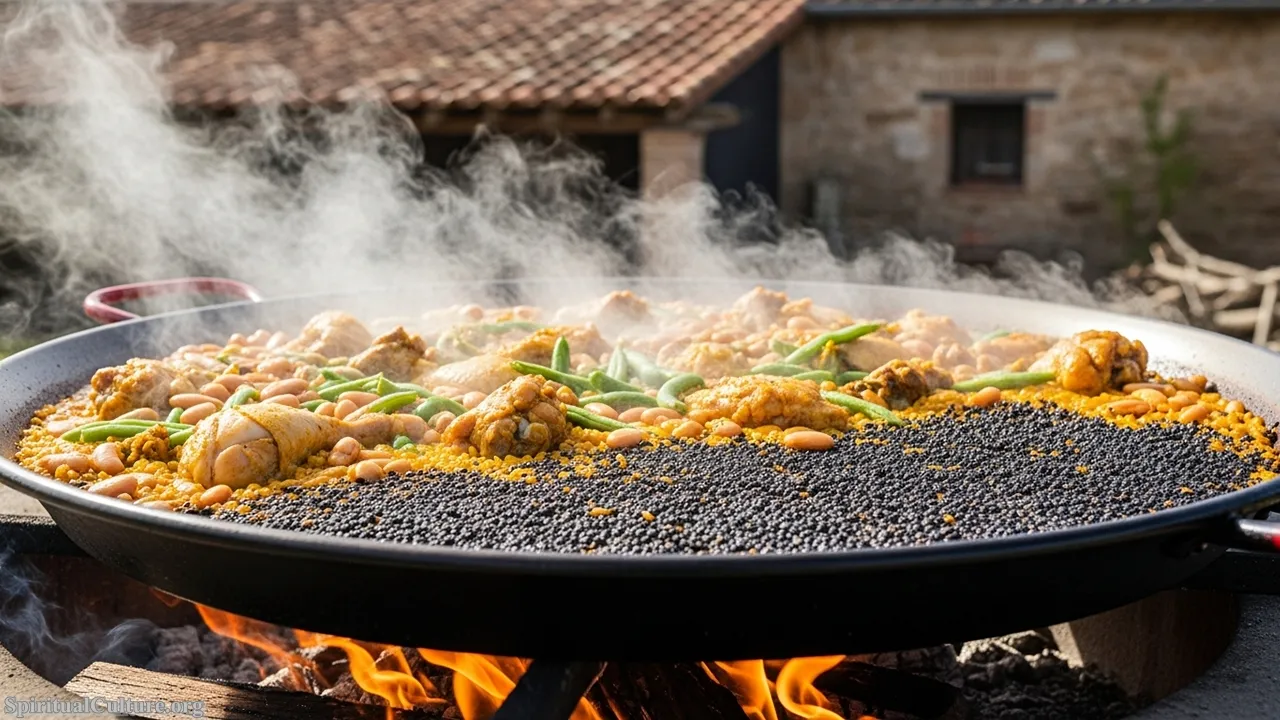
Paella’s Spiritual Anchor is Gratitude and Communal Unity. It is traditionally cooked outdoors in a wide, shallow pan (the ‘paella’), designed for sharing directly, symbolizing the circle of community and the collective contribution of ingredients. The prized crust at the bottom, the socarrat, is the essence of flavor and a symbol of good fortune—a reward for patience and proper execution. The saffron, a gift from the Moorish heritage, gives the dish its golden, almost sacred, glow, representing the sun and the life-giving harvest of the rice fields.
The moral lesson of Paella is that true fulfillment is found in sharing and in the patience required to create beauty. It mandates a collective experience, a long, leisurely meal that prioritizes family and conversation. Its preservation is crucial, as the authentic Paella Valenciana recipe protects a history of agricultural genius and a timeless cultural commitment to the Sunday family feast.
Cultural/Spiritual Highlights
- The definitive symbol of Spanish family unity and communal feasting.
- The saffron’s golden color symbolizes the sun and gratitude for the rice harvest.
- The highly sought-after socarrat is the reward for patience and skill.
- Historically a Sunday ritual, elevating a meal to a sacred weekly event.
Conclusion
The gastronomy of Spain, as detailed in this Spiritual Culture guide, is a vibrant tapestry woven with threads of Roman agriculture, Moorish spice, and New World bounty. From the ritualized slicing of Jamón Ibérico to the comforting, democratic simplicity of the Tortilla Española, each of these Top 10 dishes serves a purpose far deeper than mere caloric intake. They are cultural touchstones that mandate slowing down, sharing generously, and acknowledging the profound history on one’s plate.
The core spiritual lesson of Spanish cuisine is the sanctification of the moment: the collective joy of tapeo, the patience demanded by a bubbling Paella, and the restorative purity of a cold Gazpacho. As the world continues to move quickly, Spain’s table, as of the Current Time of Writing, offers a profound humanistic counterbalance, reminding us that the greatest sustenance comes from connection and the humble appreciation of earth’s gifts. In every shared meal, the heart of Spanish culture beats strong.





